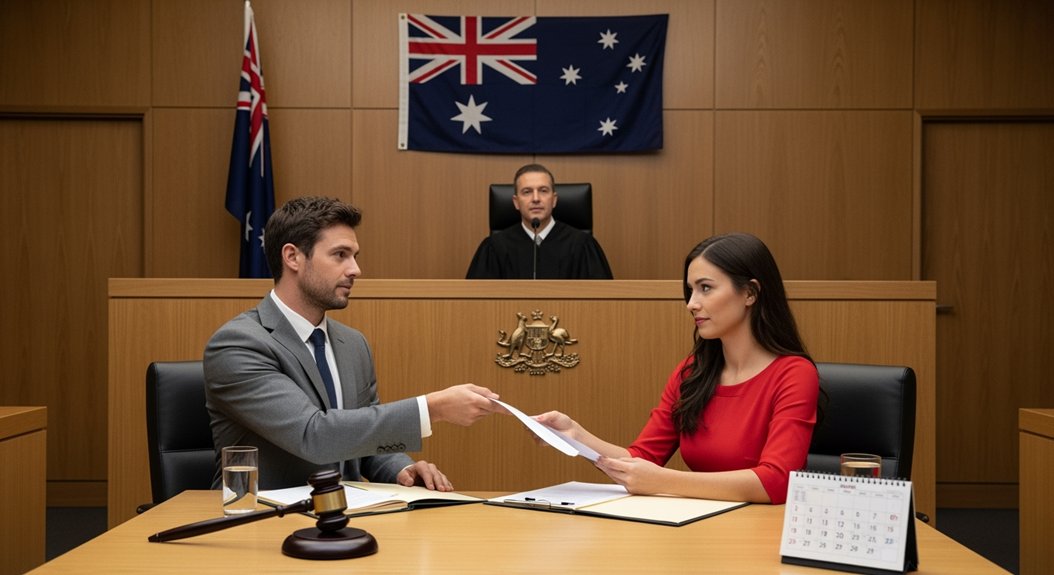Divorce in Australia generally takes about four months from application to finalisation, following a mandatory 12-month separation period. The process duration varies depending on whether the application is sole or joint, with joint applications typically being faster. Court hearings are usually brief and may be conducted electronically. Factors such as disputes over children or assets can extend timelines considerably. Understanding each stage and potential delays offers clearer expectations for managing the divorce process effectively.
Highlights
- Divorce requires a mandatory 12-month separation period to prove irretrievable marriage breakdown before filing in Australia.
- Joint divorce applications generally proceed faster and with less conflict than sole applications, which require serving papers.
- The typical timeline from filing to divorce finalisation is about four months, including a brief court hearing.
- Disputes over children, assets, or high conflict can extend divorce proceedings to 12-24 months or longer.
- Hearings are usually brief, often electronic, with mandatory attendance only in sole applications involving children or objections.
Mandatory Separation Period Before Divorce Application
The mandatory separation period is a legally required 12-month duration that must be completed before a divorce application can be filed in Australia. This period serves as proof of the marriage’s irretrievable breakdown and allows both parties time to reflect on their decisions.
A mandatory 12-month separation period is required before filing for divorce in Australia.
Couples must demonstrate that they have lived separate lives during this time, even if residing under the same roof, by showing evidence such as independent finances and separate living arrangements. The Federal Circuit and Family Court requires evidence of separation when submitting the divorce application.
Trial separations, which are informal and without legal process, provide couples a chance to test living apart before finalizing separation.
It is important to note that reconciliation lasting over three months during this period resets the mandatory separation clock, thereby delaying the divorce application.
The court assesses all relevant factors to confirm genuine separation.
Filing a Divorce Application: Sole vs. Joint
Divorce applications in Australia can be filed either as sole applications, initiated by one party, or joint applications, submitted by both parties together.
Sole applications require serving divorce papers to the other spouse, which can extend the process by several weeks.
In contrast, joint applications typically proceed more quickly due to mutual agreement and streamlined court processing. The court reviews the application and schedules a hearing date as part of the divorce process timeline.
Sole Application Process
Initiating a sole divorce application involves one party filing independently, which requires submitting the application, serving the documents on the other spouse, and potentially attending court if children under 18 are involved. Sole applications often face service challenges, as locating and properly serving the respondent can delay the process. The entire procedure typically spans several months, including a mandatory waiting period. It is important to note that the divorce is finalised 1 month and 1 day after the hearing, marking the official end of the process.
| Step | Duration/Requirement |
|---|---|
| Filing Application | 1-2 weeks |
| Serving Documents | 2-4 weeks (service challenges) |
| Court Attendance (if required) | For children under 18 |
Strict adherence to legal service requirements is essential to avoid delays. Sole applications proceed without the other spouse’s cooperation, allowing divorce even if one party is unresponsive.
Joint Application Benefits
Joint applications offer several advantages by requiring mutual consent and signatures from both spouses, streamlining the divorce process.
These joint application benefits facilitate faster processing and reduce legal intricacies, often resulting in a more cost-effective and efficient resolution. Additionally, the mutual agreement fosters emotional ease, minimizing conflict and stress during proceedings. One important requirement is that couples must have been separated for at least 12 months before applying, ensuring the application reflects the separation period.
Key joint application benefits include:
- No Service Required: Eliminates the need to formally serve divorce papers.
- Reduced Conflict: Mutual consent helps avoid disputes and promotes cooperation.
- Speedier Resolution: Courts generally process joint applications more quickly than sole applications.
Typical Timeline From Application to Divorce Finalisation
Although the duration may vary depending on specific circumstances, the typical timeline from filing a divorce application to finalisation in Australia generally spans around four months.
The divorce process begins with submitting the application, either jointly or solely. For sole applications, serving the application on the respondent is mandatory, initiating the formal court process.
Court hearings are scheduled, particularly when children under 18 are involved or if it is a sole application, with waiting times around 2-3 months. Hearings typically last under 30 minutes, and if all requirements are met, the divorce order is granted the same day.
The divorce becomes final one month and one day after the hearing, marking the legal end of the marriage. It is important to note that there is a minimum separation period of 12 months and 1 day before applying for divorce.
Strict adherence to the application timeline guarantees minimal delays throughout this process.
Factors That Can Extend Divorce Duration
Several factors contribute to extending the duration of divorce proceedings in Australia. Cases involving disputes over child custody and asset division often require additional evaluations and negotiations, leading to longer timelines.
High conflict between parties, especially when they are unwilling to negotiate or mediate, typically results in contested divorces that can last from 12 to 24 months or more.
High-conflict divorces where parties resist negotiation often extend to 12-24 months or longer.
Court system limitations, such as resource availability and scheduling delays, further prolong the process. It is advisable to consult a family lawyer to clarify expected timelines specific to individual circumstances, as this can provide insight into the divorce process timeline.
- Complex child custody disagreements necessitating thorough court assessment
- Complicated asset division involving properties, investments, or businesses
- Court backlogs and limited availability of judges and administrative support
These elements collectively contribute to variations in divorce duration, impacting the overall time required for finalisation.
Court Hearing Requirements and Procedures
Divorce hearings in Australia are generally brief and conducted electronically, with attendance requirements varying based on the application type and presence of children.
Sole applicants with minors or cases involving opposition must attend, while joint applications typically do not require court appearance.
The hearing confirms compliance with legal criteria before the registrar grants the divorce.
Attendance Rules
When filing for divorce in Australia, attendance at court hearings is generally governed by specific rules that depend on the nature of the application and the presence of children under 18.
Attendance implications include mandatory presence for sole applications involving children or if an objection is filed. Attendance exceptions typically apply to joint applications and uncontested cases without children. In some cases, legal representation can attend on behalf of an absent party to ensure proceedings continue smoothly without delay (legal representation).
Electronic attendance via telephone is permitted, facilitating remote participation.
- Mandatory attendance required for sole applications with children under 18
- Joint applications usually exempt from attendance requirements
- Courts may grant exceptions for practical challenges or allow electronic attendance
Parties must notify the court of their attendance intentions, with legal representation able to manage attendance or non-attendance.
The court retains discretion to order attendance as necessary to guarantee procedural fairness.
Hearing Process
How are divorce hearings conducted in Australia, and what do they entail?
Divorce hearings are brief, typically conducted by phone, focusing exclusively on verifying statutory requirements such as legal marriage, residency or citizenship, and a minimum 12-month separation.
The court registrar presides, with responsibilities including reviewing applications, ensuring compliance with procedural rules, and determining if grounds for divorce are met.
Hearing etiquette requires applicants to be punctual, prepared, and respectful during the process. The registrar does not consider fault, property, or child-related matters.
If documentation is insufficient, hearings may be adjourned for further information. Upon approval, a divorce order is issued, finalizing the divorce one month and one day later.
This streamlined process supports efficiency while safeguarding legal criteria.
Role of Mediation and Dispute Resolution
The effectiveness of mediation and dispute resolution plays an essential role in expediting the divorce process in Australia. Mediation benefits include fostering open communication and encouraging collaborative conflict resolution, reducing reliance on adversarial court proceedings. The Family Law Act 1975 encourages mediation as a means for early and cost-effective resolution of disputes.
This voluntary, confidential process facilitates negotiations through guided discussions, helping parties reach mutually agreeable solutions faster. By settling key issues such as parenting arrangements and asset division outside court, mediation shortens divorce timelines and lowers emotional tensions.
Key aspects of mediation include:
- Voluntary sessions led by a neutral third party to promote fair, good faith negotiation
- Drafting agreements like parenting plans or consent orders to formalize resolutions
- Reducing procedural delays by avoiding contested court hearings and litigation
Geographic and Procedural Variations in Divorce Process
Geographic location and procedural choices greatly influence the duration and intricacies of divorce proceedings in Australia.
Geographic disparities manifest as shorter wait times in metropolitan areas like Brisbane, where divorces typically take 4-6 months, compared to longer delays in rural regions due to limited court sessions and logistical challenges.
Procedural intricacies arise from the type of application: sole applications often extend timelines due to mandatory service and potential court attendance, especially when children under 18 are involved. A mandatory 12-month separation period must be observed before filing, which fundamentally sets the earliest possible start for the divorce process.
Joint applications generally expedite the process by eliminating service requirements and court appearances when no children are involved.
Additionally, courts prioritize child welfare, which may introduce further procedural steps and extend timelines.
These geographic and procedural variations collectively shape the overall duration and intricacies of divorce cases nationwide.
Frequently Asked Questions
Can I Change My Divorce Application After Filing?
Divorce application changes after filing are limited, primarily allowing minor corrections such as typographical errors. Significant filing procedure modifications generally require withdrawing and refiling the application, ensuring accuracy and compliance with court regulations throughout the process.
What Happens if My Spouse Doesn’T Respond to the Divorce Papers?
If there is no spousal response to divorce papers, the court may grant a default judgment, potentially accelerating the divorce timeline; however, delays or increased costs can arise if the spouse contests later or additional information is required.
Are There Any Fees Associated With Filing for Divorce?
Divorce application fees in Australia currently amount to $1060 for court filing costs. Payment methods include online, EFTPOS, debit, or credit card, with exemptions available for financial hardship or concession card holders.
How Does Divorce Affect My Name Change Options?
Divorce permits optional name changes, with legal requirements mandating certified divorce documentation. Individuals may retain married surnames or revert to previous names, ensuring compliance with local laws and updating official records accordingly without affecting parental responsibilities.
Can I Get Legal Aid for My Divorce Proceedings?
Legal aid eligibility for divorce process assistance depends on income, assets, and case complexity. Priority is given to cases involving domestic violence or child custody. Applicants must submit financial documentation to the relevant agency for assessment.










